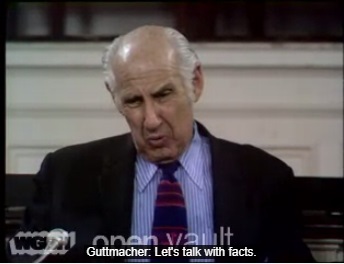This article is part two in a series on the history of Planned Parenthood. Read part one here.
Planned Parenthood founder Margaret Sanger’s focus was eugenic sterilization and birth control, rather than decriminalizing abortion. But it wasn’t a female eugenics crusader who rolled out the abortion agenda of Planned Parenthood — that came from Dr. Alan F. Guttmacher, a physician and past vice-president of the American Eugenics Society who was already steeped in abortion prior to his election as president of the Planned Parenthood Federation of America (PPFA) in 1962. Guttmacher worked with Mary S. Calderone, who joined Planned Parenthood’s staff in 1953 as its medical director, a post she held until 1964. Years earlier, Guttmacher had vowed to work to decriminalize abortion, eventually persuading the PPFA board to commit the procedures.
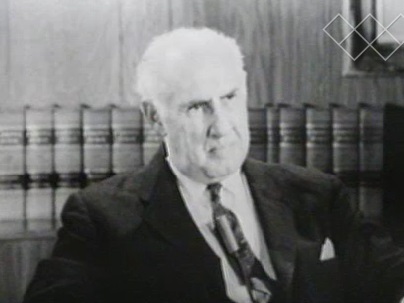
PPFA president Alan F Guttmacher speaks about abortion, 1965
Planned Parenthood was initially reluctant to perform abortions — that is, until Guttmacher came on the scene. Before making millions committing abortions, Planned Parenthood admitted that abortion takes human life. A Planned Parenthood pamphlet from 1952 reads, “Abortion kills the life of a baby after it has begun.”
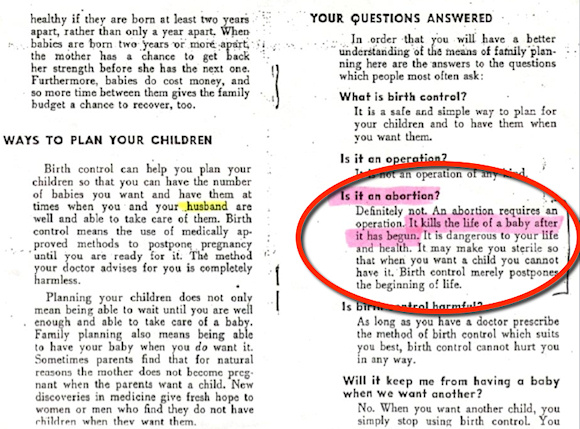
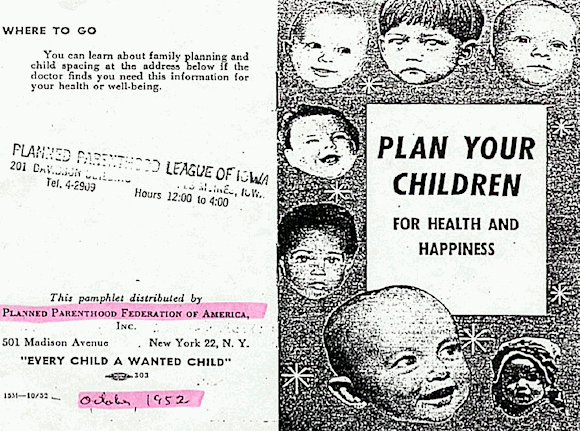
Another pamphlet from Planned Parenthood Federation of America also describes abortion as a procedure that “kills life after it has begun” and one which is “dangerous” to a woman’s “life and health.”

In the early 1960s, abortion enthusiasts like Larry Lader bemoaned Planned Parenthood’s lack of involvement with abortion, noting in his book, “Abortion II,” that “Abortion never became a feminist plank in the United States among the suffragettes or depression radicals. It was ignored, even boycotted by Planned Parenthood women in those days.”
Lader notes in his book, “Ideas Triumphant” how, other than the National Organization for Women (NOW), few groups were willing to support abortion: “In medicine, only the American Public Health Association (APHA) had taken a stand…. The huge network of Planned Parenthood Federation clinics remained on the sidelines except for its outspoken medical committee under Dr. Alan Guttmacher.”
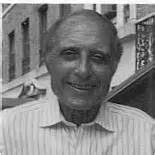
Lawrence Lader, abortion crusader
Lader expounds further in his book, “Abortion II,” writing, “Planned Parenthood, with hundreds of chapters and clinics throughout the country, had been a particular disappointment. Legalized abortion, I insisted from the start, was the logical measure for contraception and an essential form of birth control. Under the leadership of Dr. Alan Guttmacher, the medical committee of Planned Parenthood-World Population proposed the ‘abolition of existing statutes and criminal laws regarding abortion’ in 1968. After this plank was approved by the members in 1969, Planned Parenthood chapters soon started abortion referrals, and even clinics, as an ‘integral part of medical care.'”
Guttmacher was an avid eugenicist, who joined others of his day in voicing a concern about rising population growth. In spite of national calls for coercion to slow down the rate of population growth, Guttmacher instead advocated the decriminalization of abortion as an effort that he felt would accomplish the same result. But, although Guttmacher had learned how to finesse the rhetoric, he did not discount the use of coercion altogether. In 1966, Guttmacher compared the world population with the threat of nuclear war, telling the Washington Post that governments may have to act officially to limit families. “It may be taken out of the voluntary category,” Guttmacher said.
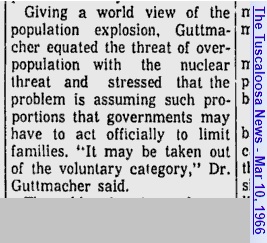
Guttmacher abortion coercion possible
Population concerns drove public policy
In Michael W. Perry’s compilation of one of Sanger’s works with others of her period, “The Pivot of Civilization in Historical Perspective: The Birth Control Classic,” Perry writes of Alan Guttmacher, “In 1962, Alan Guttmacher, former vice president of the American Eugenics Association, assumed the presidency of Planned Parenthood. Soon, a ‘population bomb’ hysteria… was driving public policy. In 1969, a medical news magazine revealed what was really going on when it quoted Guttmacher, warning that if ‘voluntary means’ did not achieve the desired goals, ‘Each country will have to decide its own form of coercion and determine when and how it should be employed. At present, the means available are compulsory sterilization and compulsory abortion.'”
“That’s what [Margaret] Sanger intended to do with birth control…. So, why should it be surprising that Guttmacher felt the same?” Perry added.
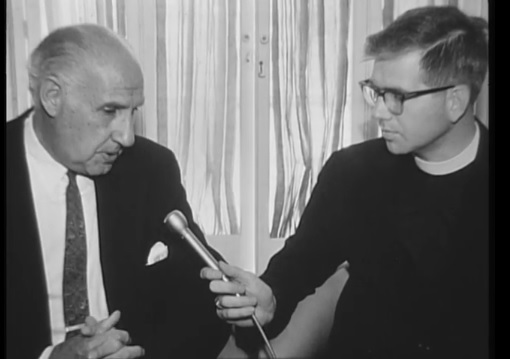
This 1968 interview with Alan Guttmacher and a member of the clergy, which, according to Ball State University, originated from WLBC-TV and was (possibly) a part of a segment titled, “Week in Review,” demonstrates the concern the PPFA president had about the so-called “population crisis.” Guttmacher began the interview by defining Planned Parenthood as a “movement which tries to make each child a wanted child born to responsible parents….”
In the interview, Alan Guttmacher, addressed the issue of population growth:
“Now, I think everyone is conscious of the fact that in some areas of the world there is explosive type of population increase, unsupportable, in that it is outdistancing food, it retards economic development… and, what we are attempting to do, of course, is to encourage countries to curtail the rate of growth.”
He added this about the threat of a global “population crisis:”
Now, I’ve been in this a really long time and I am encouraged because, we have governments becoming deeply involved. Each year, one or more – many governments make population control part of national policy.
In 1969, after seeking government funding for “family planning” specifically for “low income Americans,” Guttmacher responded to criticism from some that population growth could be reduced by “voluntary methods” rather than government coercion. “I do not share their despair,” he stated. “The appropriate response, in my view, is to mobilize rapidly a total, coordinated U.S. program by government, in collaboration with voluntary health services, in an all-out maximum effort to demonstrate what voluntary fertility control can accomplish in a free society.”
A year later, in 1970, Guttmacher, told Boston Magazine that the United Nations should be the organization the United States used to carry out population control programs worldwide. Guttmacher explained his reasoning:
If you’re going to curb population, it’s extremely important not to have it done by the dammed Yankees, but by the UN. Because the thing is, then it’s not considered genocide. If the United States goes to the black man or the yellow man and says slow down your reproduction rate, we’re immediately suspected of having ulterior motives to keep the white man dominant in the world. If you can send in a colorful UN force, you’ve got much better leverage.
The fact is that Guttmacher understood that coercive means of population control would not be well received, especially by members of the Black community. The eugenics movement, of which he was a part, had come under criticism after the Nazis’ implemented their eugenic “final solution” for a “pure race” — something many believe originated with American eugenics leaders.
“So even though the plan [of coercion] may be desirable and would make us a stronger nation, a less polluted nation, I feel it would be strategically unwise at this time,” the former Planned Parenthood president told Lee McCall, a reporter for the Sarasota Herald Tribune in 1966.
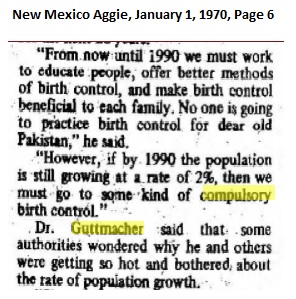
Guttmacher Compulsory Birth Control 1970
The push for taxpayer-funded birth control for the poor and minorities
Guttmacher, who also founded Planned Parenthood’s research arm and “special affiliate,” the Guttmacher Institute, then proposed a blueprint to force taxpayers to pay for birth control access for the poor, as Live Action News detailed previously.
The plan was highly criticized by the Black community, which saw the move as a means of racist Black genocide. “Among other things, this policy has brought the Planned Parenthood Federation under attack from black militants who see ‘family planning’ as a euphemism for race genocide,” the NYT reported at that time. So, a 1966 internal memo from Alan Guttmacher and Fred Jaffe outlined a new “community relations program” for winning over the Black community by “form[ing] a liaison between Planned Parenthood and minority organizations.” The plan, according to Planned Parenthood, was to emphasize that “all people have the opportunity to make their own choices,” rather than, as the memo states, “exhortation telling them how many children they should have.”
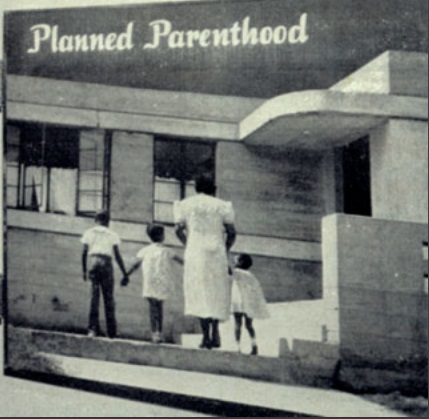
Image from 1940’s Birth control pamphlet published by Planned Parenthood
In its 1969 article entitled, “Dr. Guttmacher is the Evangelist of Birth Control,” the New York Times was forced to acknowledge that many leaders sitting on Planned Parenthood’s board were in favor of coercive measures of population control. While painting the picture of an agency which was pushing birth control on the “ghetto” rather than the “middle-class” who were having more than the optimal amount of children, the paper noted that a “sizable” number of Planned Parenthood’s board was made up of “preponderantly white and well-to-do” people. They then quoted a Planned Parenthood board member who admitted the racist attitude of the organization when he stated, “What it all comes down to is that we want the poor to stop breeding while we retain our freedom to have large families. It’s strictly a class point of view.”
Guttmacher and Sanger were both (as eugenicists) concerned that the world population was a threat, but, Guttmacher, much savvier than Sanger, chose to couch his agenda as a “right.” He even told the paper that they were not trying to take away anyone’s rights, but trying to “show ghetto families how to space their children and avoid having children they don’t want.”
“Admittedly Guttmacher is buying time,” writes the New York Times in that 1969 report. “He thinks the voluntary movement should set a deadline of 1980. If world population growth has not dropped below 1.5 percent by then, he says, ‘we’ll have to get tough.'”
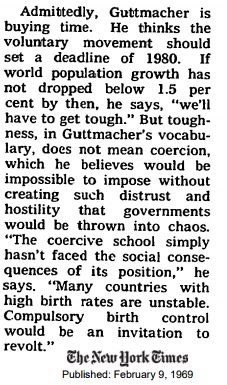
Guttmacher on coercive population control New York Times
Whatever Guttmacher meant by getting “tough” never materialized, because he believed decriminalizing abortion was the solution and noted this in a 1970 interview where he stated:
If we could get the abortion law liberalized, most of the 750,000 unwanted pregnancies would not lead to babies – rejected children, battered baby syndrome and illegal abortions.
Proposing the availability of “unlimited abortion” to curb population growth
And, in that same year, Guttmacher admitted to a 1970 Cornell Symposium, (according to an April 7, 1970, article published by the Cedar Rapids Gazette), that although he did not know when life began, he believed that “unlimited abortion” was the only way to reduce population growth, saying, “There is no question that the most effective way of reducing population growth is by unlimited abortion.”
According to researcher and author Mary Meehan, “Guttmacher undoubtedly believed that [abortion] helped women; in fact, he had referred patients to an illegal abortionist as early as 1941. Yet he also had other motives, indicated by his service as vice president and board member of the American Eugenics Society.”
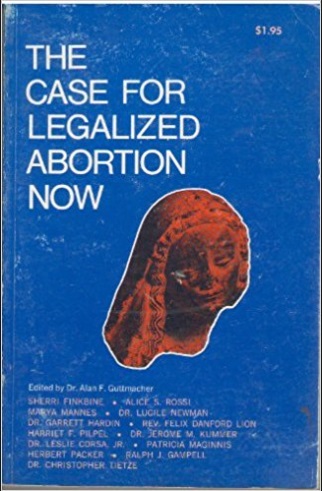
The Case for Legalized Abortion Now, edited by Alan F Guttmacher
In 1967, Guttmacher edited a book on legalizing abortion, where he admitted, “Today it is possible for almost any patient to be brought through pregnancy alive, unless she suffers from a fatal illness such as cancer or leukemia, and, if so, abortion would be unlikely to prolong, much less save, life.” Former abortionist Dr. Anthony Levatino agrees with this, stating that there is never a valid medical reason for abortion:
Guttmacher became Chief of Obstetrics at Baltimore’s Sinai Hospital in 1942, eventually creating a staff committee of five to make decisions about abortion. Like Sanger, Guttmacher allegedly watched a woman die from an illegal abortion while serving as an intern in Baltimore. He later wrote of other women, “In a short period I witnessed three deaths from illegal abortions: a 16-year old with a multiperforated uterus, a mother of four who died of sepsis rejecting another child, and a patient in early menopause who fatally misinterpreted amenorrhea.”

Alan Guttmacher 1973 (Image credit: WGBH)
For years, Guttmacher referred women to physicians for illegal abortion procedures. He once wrote how an illegal abortionist, nicknamed Dr. T, showed him the abortion technique. “His technique was to pack one inch gauze strips into the cervix and lower uterine segment the night before he was to evacuate the conceptus,” Guttmacher wrote. “After 12 hours of packing, the cervix was wide open, and he was able to empty the uterus with an ovum forceps, followed by currettage without anesthesia. In advanced pregnancies he inserted intrauterine bougies, held in place by a vaginal pack until strong contractions commenced, which not infrequently took several days.”
“These early medical experiences with the unavailability of abortions in reputable hospitals and the incidence of illegal abortions convinced me that permitting abortion only ‘to preserve the life of the mother’ was undesirable and unenforceable…. My sentiment was that as long as the law was as restrictive as it was, doctors should not breach it, but work to change the law – a position which I forthrightly espoused in the classroom,” Guttmacher stated.
Dr. T later attended a 1950’s Abortion in the United States conference sponsored by PPFA, which focused on abortion. PPFA leader Mary Calderone writes, “Those very concerned with the problem of abortion will be full of gratitude for this report; gratitude to the P.P.F.A. for convening the conference and for the frankness of the thirty-eight participants, who comprised eminent gynaecologists, psychiatrists and a few social workers. The highlight of the proceedings was an M.D.’s testimony as a convicted (but not imprisoned) abortionist. The chairman stated that Dr. T. was his valued friend, known for nearly three decades, and described him as ‘an extremely competent abortionist … who some years ago fell into disagreement with the law and is no longer in practice”.'”
The PPFA group heard from abortion advocates worldwide, and in the end, Calderone indicates that there was no clarion call to push for abortion reform.
In his book, “Babies by Choice or by Chance,” published in 1959, Guttmacher allegedly deplored “the performance of abortion on virtual demand.” But Guttmacher also noted how he had learned from experience how hospitals were “allowed to interpret and administer the abortion law of their respective states without supervision or interference from either the police, the courts or medical agencies.”
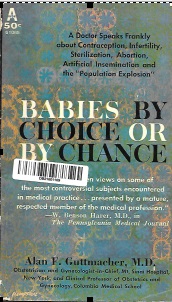
Babies by Choice or By Chance, by Alan F Guttmcher
In 1952, Guttmacher had relocated from Baltimore to New York, where he became the first Director of Obstetrics and Gynecology at the Mount Sinai Hospital, which had already been approving and performing abortions. “I was told that if a private patient was denied abortion in another institution, she frequently sought abortion at Mt. Sinai because of its well-known, relatively liberal policy,” Guttmacher claimed.
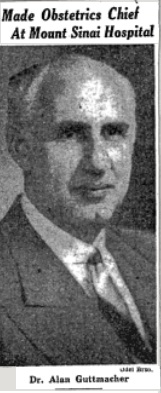
Alan Guttmacher appointed head of obstetrics at Mount Sinai Hospital (Image New York Times June 27,1952)
By 1962, Guttmacher was at the helm of Planned Parenthood and he was positioned to put his dream of decriminalizing abortion into action. That same year, as chairman of the medical and scientific committee of the Human Betterment Foundation, Guttmacher called the existing abortion laws “archaic” and “idiotic.”
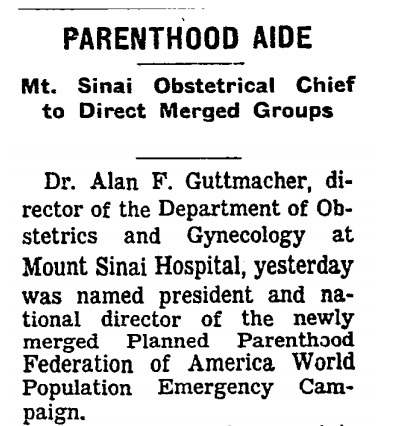
Guttmacher named president of Planned Parenthood, 1967 (Image: New York Times)
“The idea that the fetus has a sacred right to survive from the moment of fertilization is a Judeo Christian creation,” he said according to a May 2, 1962, Poughkeepsie Miscellany News report.

Alan Guttmacher calls 1960 abortion laws archaic
“I believe that a new abortion statute for New York and each of the other states is needed…. I think it is high time that a commission of physicians, lawyers, judges, sociologists, and religionists convened in an attempt to wrestle with the problem realistically…. The only way progress can be made is through an aroused citizenry. What we need in the United States is a uniform abortion law,” Guttmacher wrote in “Babies by Choice.”
A few years later, during a 1965 “Abortion and the Law” BBC program, Guttmacher, then president of PPFA, put forth the infamous “health” exception for abortion, stating (36:20):
Now, the law as you know is simply to preserve the life of the mother. This is wholly inadequate.
Number one, I’d preserve the life or health of the mother. And, as you know, health could be interpreted quite broadly and I think it should be. In 1960, the World Health Organization gave us splendid definition of health. They said health is a state of complete physical, mental and social well being. Not simply the absence of illness and disease.
Second, I feel that abortion should be done, when competent medical opinion feels that there’s strong likelihood of the current [inaudible] to result in the malformed or abnormal child. I think whenever pregnancy is the result of proved rape, incest, or the impregnation of a child of sixteen or less, with or without the consent, that we have legal grounds for interrupting this pregnancy.
Interestingly, this language comes directly from the 1959 American Law Institute’s Model Penal Code on abortion. In our next report in this series, we will learn Guttmacher’s connection to that organization and detail what led up to Planned Parenthood’s decision to push for the decriminalization of abortion and begin referring for the procedure.
This was part two in Live Action News’ series on the history of Planned Parenthood’s move to committing abortions. You can read part one , part three, and part four in additional articles.

